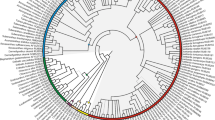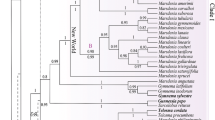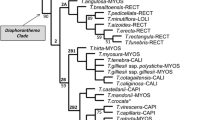Abstract
Barbeya is a monotypic genus in the Horn of Africa and adjacent parts of Arabia. It is usually treated as the familyBarbeyaceae and regarded as an aberrant member ofUrticales. Dirachma, with one species on Socotra and one in Somalia, is usually treated as the familyDirachmaceae, inGeraniales, but a position inMalvales has also been suggested. Analyses of molecular data, from bothrbcL andtrnL-F, indicate thatBarbeya andDirachma are closely related inter se as well as toRhamnaceae andElaeagnaceae. In an analysis based on morphologyBarbeya groups withElaeagnaceae, andDirachma withRhamnaceae andUlmaceae. In a combined molecular and morphological analysisBarbeya is the sister group ofElaeagnaceae andDirachma is the sister group of the wholeBarbeya-Elaeagnaceae-Rhamnaceae clade. However, the support for these arrangements is weak and, rather than mergingBarbeyaceae withDirachmaceae as suggested by the molecular analysis or withElaeagnaceae as suggested by the morphological and combined analyses, it seems best to retain bothBarbeyaceae andDirachmaceae in their present circumscriptions, but in both cases in completely new positions in the angiosperm system. The results are compatible with a new circumscription ofRhamnales comprisingRhamnaceae, Elaeagnaceae, Dirachmaceae andBarbeyaceae.
Similar content being viewed by others
References
Backlund, A., Bremer, K., 1998: To be or not to be — principles of classification and monotypic plant families. — Taxon (in press).
Balfour, I. B., 1884: Diagnoses plantarum novarum phanerogamarum socotrensium. Pars quarta (Supplementum). — Proc. Roy. Soc. Edinburgh12: 402–411.
- 1888: Botany of Socotra. — Trans. Roy. Soc. Edinburgh31.
Barabe, D., Bergeron, Y., Vincent, G. A., 1982: Etude quantitative de la classification desHamamelididae. — Taxon31: 619–645.
Bentham, G., Hooker, J. D., 1880: Genera plantarum,3(1). — London: Reeve.
Berg, C. C., 1989: Systematics and phylogeny of theUrticales. — InCrane, P. R., Blackmore, S., (Eds): Evolution, systematics and fossil history of theHamamelidae,2, pp. 193–220. — Syst. Ass. Spec. Vol.40B. — Oxford: Clarendon Press.
Boesewinkel, D., Bouman, F., 1997: Ovules and seeds ofDirachma socotrana (Dirachmaceae). — Pl. Syst. Evol.205: 195–204.
Bouman, F., Boesewinkel, D., 1997: Ovules and seeds ofBarbeya with additional arguments for an urticalean affinity of theBarbeyaceae. — Acta Bot. Neerl.46: 255–261.
Bremer, B., Andreasen, K., Olsson, D., 1995: Subfamilial and tribal relationships in theRubiaceae based onrbcL sequence data. — Ann. Missouri Bot. Gard.82: 383–397.
Chase, M. W., & al., 1993: Phylogenetics of seed plants: an analysis of nucleotide sequences from the plastid generbcL. — Ann. Missouri Bot. Gard.80: 528–580.
Corner, E. J. H., 1976: The seeds of dicotyledons,1 &2. — Cambridge: Cambridge University Press.
Cronquist, A., 1981: An integrated system of classification of flowering plants. — New York: Columbia University Press.
, 1988: The evolution and classification of flowering plants, 2nd edn. — New York: The New York Botanical Garden.
Dahlgren, G., 1989: The last Dahlgrenogram. System of classification of the dicotyledons. — InKit Tan, (Ed.): TheDavis andHedge Festschrift, pp. 249–260. — Edinburgh: Edinburgh University Press.
Dahlgren, R., 1983: General aspects of angiosperm evolution and macrosystematics. — Nordic J. Bot.3: 119–149.
Darnley Gibbs, R., 1974: Chemotaxonomy of flowering plants,1–4. — Montreal, London: McGill-Queen's University Press.
Dickison, W. C., Sweitzer, E. M., 1970: The morphology and relationships ofBarbeya oleoides. — Amer. J. Bot.57: 468–476.
Engler, A., 1897:Ulmaceae. — InEngler, A., Prantl, K., (Eds): Die natürlichen Pflanzenfamilien. Nachträge3(1). — Berlin: Borntraeger.
, 1936: Syllabus der Pflanzenfamilien. — Berlin: Borntraeger.
Esau, K., 1977: Anatomy of seed plants, 2nd edn. — New York: Wiley.
Felsenstein, J., 1985: Confidence limits on phylogenies: An approach using the bootstrap. — Evolution39: 783–791.
Friis, I., 1993:Barbeyaceae. — InKubitzki, K., (Ed.): The families and genera of vascular plants, pp. 141–142. — Berlin, Heidelberg, New York: Springer.
Giannasi, D. E., 1978: Generic relationships in theUlmaceae based on flavonoid chemistry. — Taxon27: 331–344.
, 1986: Phytochemical aspects of phylogeny inHamamelidae. — Ann. Missouri Bot. Gard.73: 417–437.
Goldberg, A., 1986: Classification, evolution, and phylogeny of the families of dicotyledons. — Smithsonian Contrib. Bot.58: 1–314.
Hegnauer, R., 1966: Chemotaxonomie der Pflanzen,4. — Basel, Stuttgart: Birkhäuser.
, 1973: Chemotaxonomie der Pflanzen,6. — Basel, Stuttgart: Birkhäuser.
Hutchinson, J., 1959: The families of flowering plants, 2nd edn.,1. — Oxford: Clarendon Press.
, 1964: The genera of flowering plants,1. — Oxford: Clarendon Press.
, 1969: Evolution and phylogeny of flowering plants. — London, New York: Academic Press.
, 1973: The families of flowering plants, 3rd edn.,1. — Oxford: Clarendon Press.
Kubitzki, K., 1993: Introduction. — InKubitzki, K., (Ed.): The families and genera of vascular plants,2, pp. 1–12. — Berlin, Heidelberg, New York: Springer.
Link, D. A., 1991:Dirachma somalensis D. A. Link sp. nov. A new species of a remarkable and highly endangered monogeneric family. — Bull. Jard. Bot. Belg.61: 3–13.
, 1993:Dirachmaceae. — InThulin, M., (Eds): Flora of Somalia,1, pp. 191–192. — Richmond: Royal Botanic Gardens, Kew.
, 1994:Dirachma Schweinf. (Dirachmaceae) a highly remarkable and endangered bispecific genus. — InSeyani, J. H., Chikuni, A. C., (Eds): Proceedings of the XIIIth plenary meeting of AETFAT, Zomba, Malawi, 2–11 April 1991, pp. 1229–1238. — Zomba: National Herbarium and Botanic Gardens of Malawi.
Melchior, H., 1964:Ulmaceae. — InMelchior, H., (Ed.):A. Engler's Syllabus der Pflanzenfamilien, 12th edn,2: 52–54. — Berlin: Borntraeger.
Metcalfe, C. R., Chalk, L., 1950: Anatomy of the dicotyledons,1 &2. — Oxford: Clarendon Press.
Polhill, R. M., 1966:Ulmaceae. — InHubbard, C. B. E., Milne-Redhead, E., (Eds): Flora of Tropical East Africa. — London, Tonbridge: Crown Agents for Oversea Governments and Administrations.
Rendle, A. B., 1916:Barbeyaceae. — InPrain, D., (Ed.): Flora of Tropical Africa,6(2), pp. 14–15. — London: Reeve.
Schweinfurth, G., 1891:Barbeya Schwf. gen. nov. Urticacearum. — Malpighia5: 332–340.
Soltis, D. E., Soltis, P. S., Morgan, D. R., Swensen, S. M., Mullin, B. C., Dowd, J. M., Martin, P. G., 1995: Chloroplast gene sequence data suggest a single origin of the predisposition for symbiotic nitrogen fixation in angiosperms. — Proc. Natl. Acad. Sci. USA92: 2647–2651.
Suessenguth, K., 1953:Rhamnaceae. — InEngler, A., Prantl, K., (Eds): Die natürlichen Pflanzenfamilien, 2nd edn.,20d: 7–173. — Berlin: Duncker & Humblot.
Swensen, S. M., 1996: The evolution of actinorhizal symbioses: evidence for multiple origins of the symbiotic association. — Amer. J. Bot.83: 1503–1512.
Swofford, D. L., 1993: PAUP: Phylogenetic Analysis Using Parsimony. Version 3. 1. 1. Computer program. — Champaign, Illinois: Illinois Natural History Survey.
Taberlet, P., Geilly, L., Pautou, G., Bouvet, J., 1991: Universal primers for amplification of three non-coding regions of chloroplast DNA. — Pl. Molec. Biol.17: 1105–1109.
Takhtajan, A., 1966: Systema et phylogenia Magnoliophytorum. — Moscow: Nauka [in Russian].
, 1980: Outline of the classification of flowering plants (Magnoliophyta). — Bot. Rev.46: 225–359.
, 1987: Systema Magnoliophytorum. — Leningrad: Nauka [in Russian].
Thorne, R. F., 1973: The “Amentiferae” orHamamelidae as an artificial group: a summary statement. — Brittonia25: 395–405.
, 1976: A phylogenetic classification of theAngiospermae. — Evol. Biol.9: 35–106.
, 1983: Proposed new realignments in angiosperms. — Nordic J. Bot.3: 85–117.
, 1989:‘Hamamelidae’: A commentary. — InBlackmore, S., Crane, P. R., (Eds): Evolution, systematics and fossil history of theHamamelidae,1, pp. 9–16. — Syst. Ass. Spec. Vol.40A. — Oxford: Clarendon Press.
, 1992: Classification and geography of the flowering plants. — Bot. Rev.58: 225–348.
Tobe, H., Takahashi, M., 1990: Trichome and pollen morphology ofBarbeya (Barbeyaceae) and its relationships. — Taxon39: 561–567.
Vidal, J., 1963: Le genreNeillia (Rosaceae). — Adansonia3: 142–166.
Willis, J. C., 1966: A dictionary of the flowering plants and ferns, 7th edn., revised byH. K. Airy Shaw. — Cambridge: Cambridge University Press.
Yakovleva, O. V., 1994: The ultrastructure of mucilage cells in the leaf epidermis ofDirachma socotrana (Dirachmaceae). — Bot. Zhurn.79(5): 52–58.
Zavada, M. S., Kim, M., 1996: Phylogenetic analysis ofUlmaceae. — Syst. Bot. Evol.200: 13–20.
Author information
Authors and Affiliations
Rights and permissions
About this article
Cite this article
Thulin, M., Bremer, B., Richardson, J. et al. Family relationships of the enigmatic rosid generaBarbeya andDirachma from the Horn of Africa region. Pl Syst Evol 213, 103–119 (1998). https://doi.org/10.1007/BF00988911
Received:
Revised:
Accepted:
Issue Date:
DOI: https://doi.org/10.1007/BF00988911




